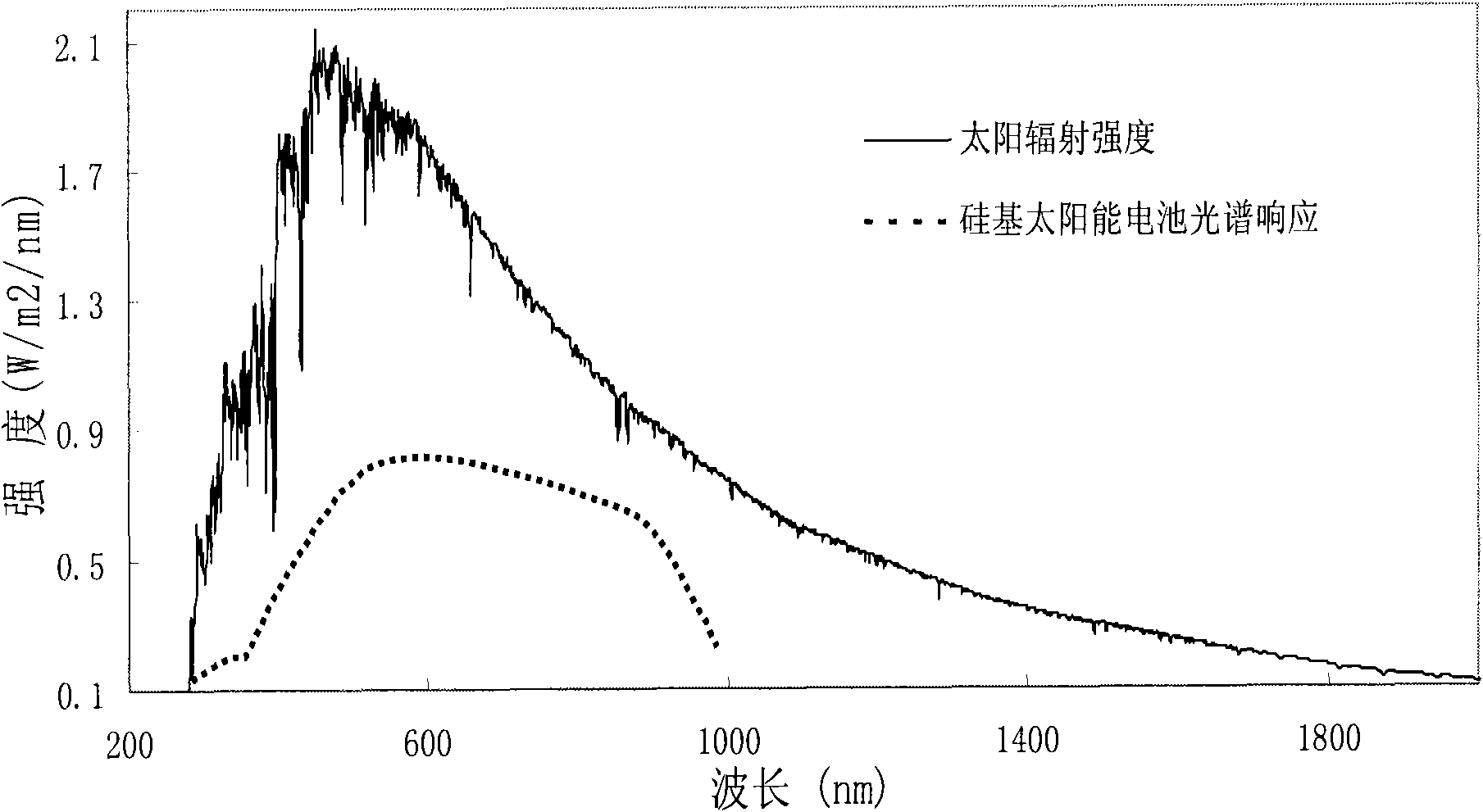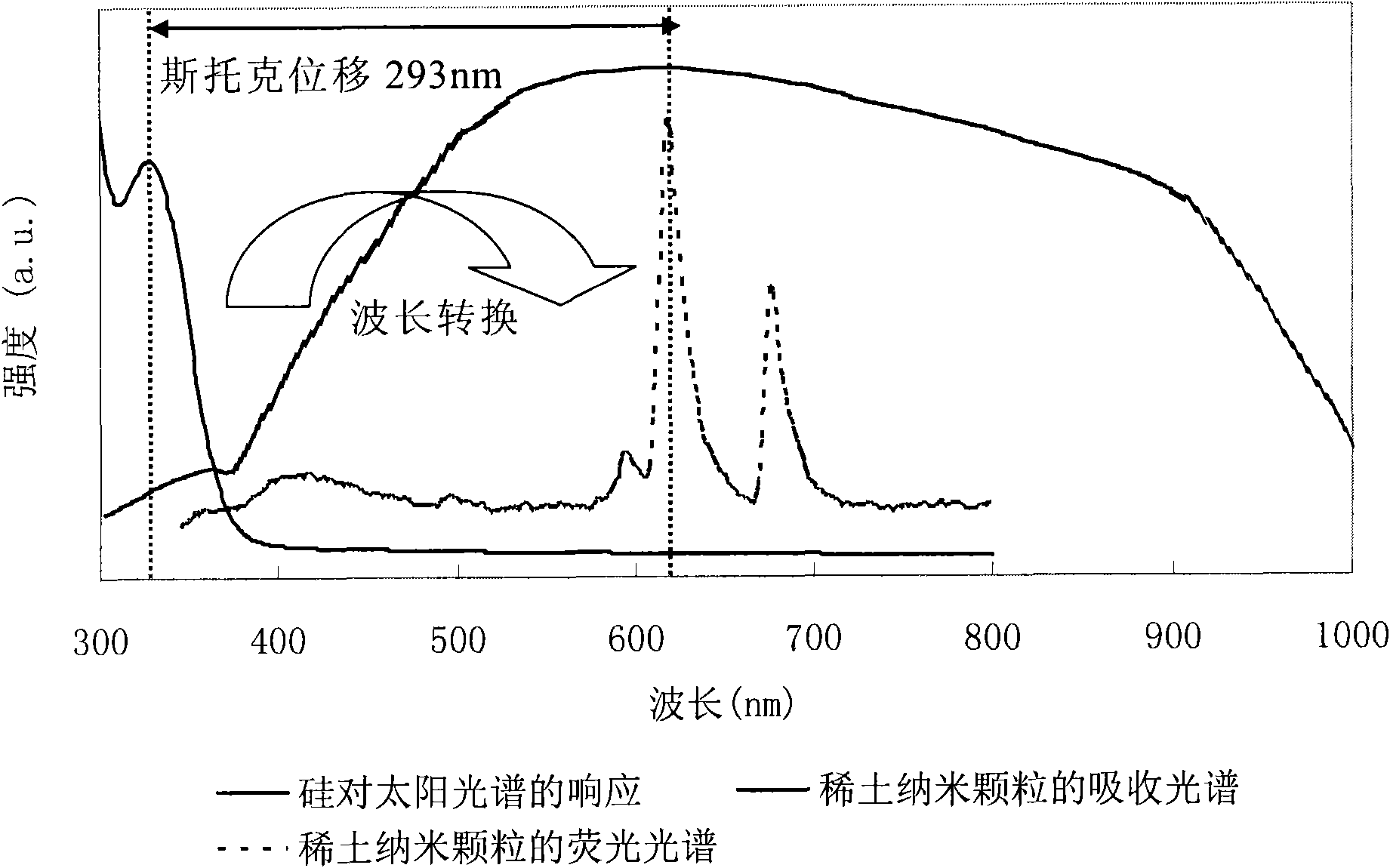Nano fluorescent particles doping with rare-earth ions and relevant application thereof
A technology of nanoparticles and rare earth metal ions, which is applied in the field of nanoparticles in solar cells, can solve the problems of large particle size of inorganic phosphors, low absorption probability quantum efficiency, and unresolved absorption probability, so as to avoid repeated absorption and realize wavelength conversion , the effect of high fluorescence efficiency
- Summary
- Abstract
- Description
- Claims
- Application Information
AI Technical Summary
Problems solved by technology
Method used
Image
Examples
Embodiment 1
[0067] Preparation of rare earth europium (Eu) doped tin dioxide (SnO 2 ) Nanoparticles: add 2mol SnCl 4 ·5H 2 O and 0.1mol EuCl 3 Dissolve in 1L deionized water. Under stirring condition, drop 2mol NH of precipitation agent 4 OH to drip into SnCl 4 ·5H:O and EuCl 3 In the solution, the end-point pH is controlled to 4 to prepare the tin dioxide precursor sol, which is left for 24 hours at room temperature for aging. Wash with deionized water and suction filtration to remove Cl ions in the colloid. Then heated at 80℃ to obtain transparent nano-SnO 2 Viscous liquid. Then put it in a muffle furnace and calcine at 500℃ for 2 hours to obtain Eu-doped SnO 2 The size range of nanoparticles is 2nm-10nm.
Embodiment 2
[0069] Preparation of rare earth samarium (Sm) doped zinc dioxide (ZnO) nanoparticles: 0.3 grams of samarium oxide (Sm 2 O 3 ) Dissolved in 20mL HNO 3 To obtain samarium oxide in nitric acid solution; add 9.7 grams of Zn(NO 3 ) 2 ·6H 2 O is dissolved in water to prepare an aqueous solution of zinc nitrate. The two solutions were mixed, heated with magnetic stirring for 1.5 hours, and then the excess nitric acid was evaporated until the pH was neutral, and then cooled to room temperature. Drop 10 mL of ammonia water drop by drop to make the solution fully precipitate, and wash with deionized water several times until the pH is neutral. The precipitate was dried at 120°C for 2 hours and annealed in a high temperature furnace at 800°C for 3 hours. After cooling and grinding, ZnO:Sm nanoparticles with an average particle size of 80 nm were obtained.
Embodiment 3
[0071] Preparation of rare earth (Tb) doped titanium dioxide (TiO 2 ) Nanoparticles: Dissolve 1ml of tetra-n-butyl titanate in 20ml of ethanol, then add 0.2ml of europium acetate (Eu(CH 3 COO) 3 ·6H 2 O) Deionized water solution. Eu ion and TiO 2 The molar ratio of 5% is 5%. Magnetic stirring was carried out at room temperature for 3 hours, and then heated at 120°C for 6 hours. The resulting precipitate was centrifuged in a centrifuge and washed repeatedly with ethanol, and then dried at 50°C. Then it was put into a muffle furnace and calcined at 600℃ for 2 hours, and the calcination temperature was increased at a rate of 4℃ / min. Tb-doped TiO was obtained. 2 The average particle size of nanoparticles is 10nm.
PUM
| Property | Measurement | Unit |
|---|---|---|
| particle diameter | aaaaa | aaaaa |
| particle diameter | aaaaa | aaaaa |
| particle diameter | aaaaa | aaaaa |
Abstract
Description
Claims
Application Information
 Login to View More
Login to View More - R&D
- Intellectual Property
- Life Sciences
- Materials
- Tech Scout
- Unparalleled Data Quality
- Higher Quality Content
- 60% Fewer Hallucinations
Browse by: Latest US Patents, China's latest patents, Technical Efficacy Thesaurus, Application Domain, Technology Topic, Popular Technical Reports.
© 2025 PatSnap. All rights reserved.Legal|Privacy policy|Modern Slavery Act Transparency Statement|Sitemap|About US| Contact US: help@patsnap.com



